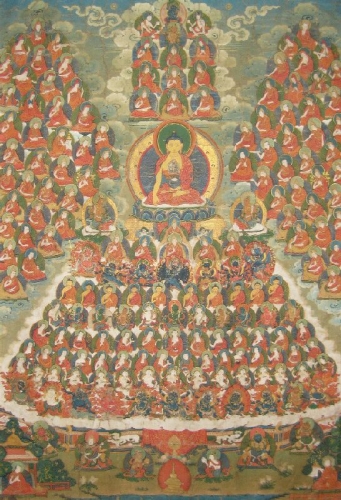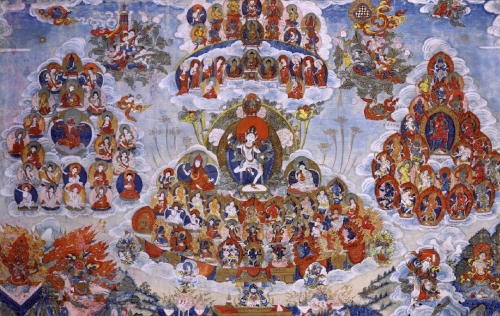Buddhist practice and Buddhist art have been inseparable in the Himalayas ever since Buddhism arrived to the region in the eighth century. But for the casual observer it can be difficult to make sense of the complex iconography. Not to worry—Himalayan art scholar Jeff Watt is here to help. In this “Himalayan Buddhist Art 101” series, Jeff is making sense of this rich artistic tradition by presenting weekly images from the Himalayan Art Resources archives and explaining their roles in the Buddhist tradition.
This week Jeff explores refuge field paintings.
Himalayan Buddhist Art 101: Refuge Field Paintings

A refuge field painting, or, more precisely, a “field of accumulation,” is a type of composition that arranges all of the lineage teachers and deities of a particular Buddhist tradition in a single composition. The correct placement of figures and elements can vary greatly depending on the individual religious tradition and the descriptions in specific liturgical texts. A refuge field functions as a physical representation that reminds a devotee of all of the most sacred objects contained in a particular tradition.
The earliest known compositions are actually not early at all. The Gelug tradition first began creating refuge field paintings in the 18th century and were very likely based on a liturgical text written by the 1st Panchen Lama, Lobzang Chokyi Gyaltsen (1570-1662). The concept of a mentally visualized field of refuge, however, can be found in earlier texts dating to the 12th century.
The six key figurative elements that make up a refuge field painting are the guru/teacher (along with lineage teachers), the Buddha, the Dharma (represented by books), the Sangha, meditational deities/Ishtadevata, and protector deities (Dharmapala). It is this hierarchical grouping of teachers, books, and deities that are the actual field of accumulation, or field for the accumulation of merit, also known as the objects of refuge.

The placement of the figures within a larger compositional format can vary greatly. The Gelug tradition chooses to use either a tree or a very large lotus flower. The Karma Kagyu also prefer a tree. Other Kagyu traditions prefer a palace, while still others choose to arrange the figures on lotus thrones supported by clouds in the sky. Some traditions prefer to stack and elevate the figures vertically according to a descending hierarchy, while others assemble the figures on a flat plane of a very large lotus flower with the Buddha or Vajradhara at the center surrounded by concentric circles of teachers, Buddhas, and deities. Needless to say, there are numerous refuge field configurations from the 18th and 19th centuries with more being created all the time from the writings of contemporary creative Lamas and imaginative artists. Generally, however, it can be said that there are three basic types of refuge field compositions, based on the support, or ground, on which the objects of refuge are placed: 1) throne and lotus, 2) palace, and 3) tree.
(NOTE: The Tibetan word “tsog zhing” is often mistakenly translated from Tibetan into English as “refuge tree.” This common mistake arises from non-Tibetan translators confusing the Tibetan word “shing”—meaning “tree”—with the word “zhing,” meaning “field,” “region,” or “realm.” The correct translation and name for this type of painting is field of accumulation, commonly known in English as a refuge field. It is also important to take note that not all refuge field paintings contain a tree.)
Thank you for subscribing to Tricycle! As a nonprofit, we depend on readers like you to keep Buddhist teachings and practices widely available.